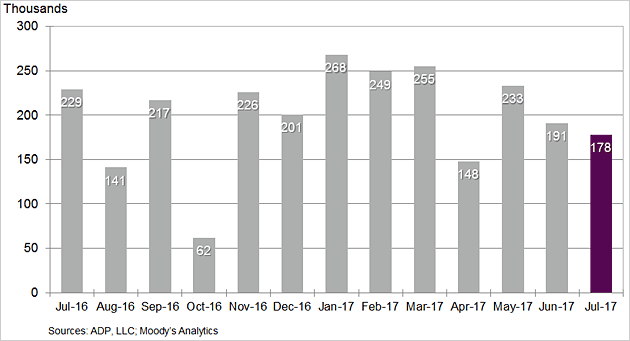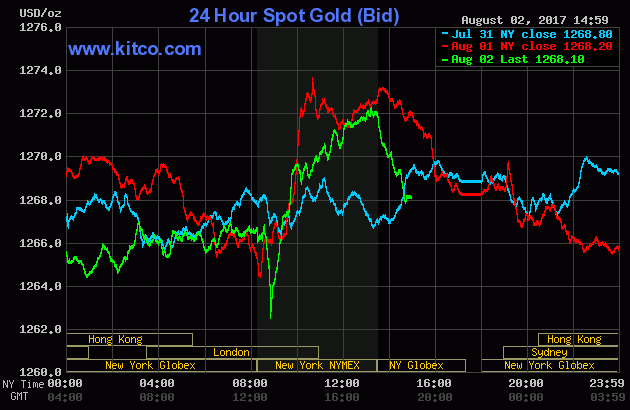This week was full of important data. How can the recent economic reports affect the gold market?
Yesterday, we analyzed data on the recent personal outlays and income. However, more interesting economic reports were released this week. Let’s start with Wednesday’s ADP. The U.S. nonfarm private sector added 178,000 jobs, following 191,000 in June (after upward revision). The change is generally in line with expectations, but the downward trend, which started at the beginning of the year, continued, as one can see in the chart below.
Chart 1: Change in nonfarm private employment over the last twelve months (source: ADP).

This was positive news for the gold market, as the price of gold increased after the release of the report (after the initial slide), as the chart below shows. This is because the ADP report may provide some clues about Friday’s government’s report. However, the report noted broad-based employment gains, which remained satisfactory. And gold investors should remember that the ADP has not been giving a clear signal recently.
Chart 2: Gold prices over the three last days.
When it comes to other data, the U.S. manufacturing sector remained solid. The ISM Manufacturing Index fell from a three year high of 57.8 percent in June to 56.3 percent last month. It means that the American manufactures slowed down a bit, but still expanded very fast. Similarly, the U.S. Manufacturing Purchasing Managers’ Index rose from 52 in June to 53.3 in July, which signals further improvement in the manufacturing sector.
And the vehicle sales rose to 16.73 million in July, up from 16.64 million in June (numbers are seasonally adjusted annual rates). On the other hand, construction spending declined 1.3 percent in June. On an annual basis, outlays for construction projects were 1.6 percent higher, but the downward trend is clear. The impact of data on auto sales and construction spending on the gold market should be limited. Now, all eyes are on Friday’s payrolls.
Nevertheless, the latest bunch of the U.S. economic data signals the modest continuation of the recovery. The latest readings of the manufacturing indices signal strength for the sector and the overall economy. In such an environment, gold may struggle. However, the current positive sentiment toward the yellow metal and the economic expansion outside the U.S. are bullish factors in the gold market. Stay tuned!
Disclaimer: Please note that the aim of the above analysis is to discuss the likely long-term impact of the featured phenomenon on the price of gold and this analysis does not indicate (nor does it aim to do so) whether gold is likely to move higher or lower in the short- or medium term. In order to determine the latter, many additional factors need to be considered (i.e. sentiment, chart patterns, cycles, indicators, ratios, self-similar patterns and more) and we are taking them into account (and discussing the short- and medium-term outlook) in our trading alerts.

